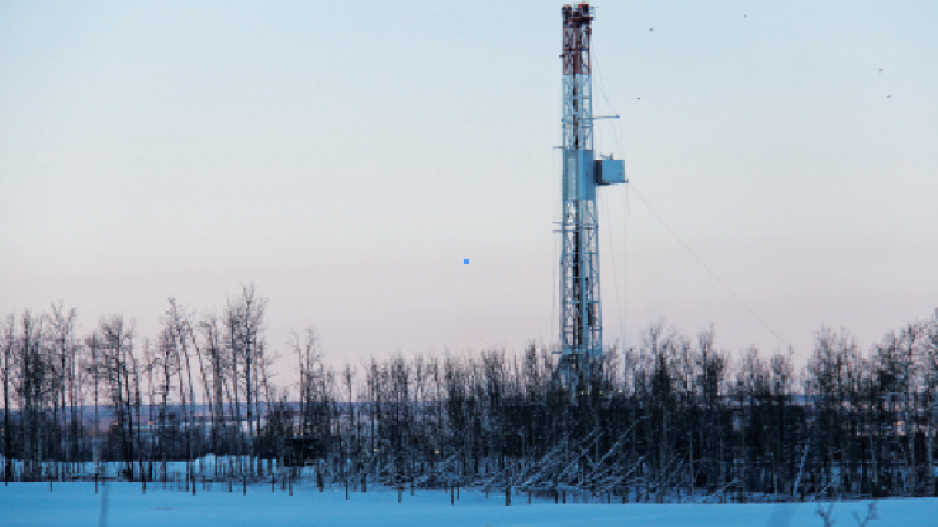Low prices might be curbing oil and gas drilling in some parts of the world, including Alberta, but if recent investment decisions are any indication, they have yet to cool the zeal that energy companies like Encana Corp. (TSX:ECA) have for northeastern B.C.’s Montney formation.
In December, the B.C. government generated $38 million in bonus bids for oil and gas leases to energy companies compared with $7.8 million in December 2013.
In total, B.C. generated $330 million from oil and gas leases in 2014, according to the Ministry of Natural Gas Development, and 90% of all drilling activity last year took place in just one of B.C.’s four natural gas plays: the Montney.
Encana is one of a handful of companies pouring money into the region. Just before Christmas, it announced plans to spend $600 million to $700 million in 2015 drilling there for oil, gas and natural gas liquids.
In March 2014, Petronas subsidiary Progress Energy Canada Ltd. spent $1.5 billion acquiring 127,000 acres of land and producing wells in the Montney from Talisman Energy Inc. (TSX:TLM).
In December, Painted Pony Petroleum Ltd. (TSX:PPY) announced plans to spend close to $300 million in 2015 drilling in the Montney. Shell Canada, meanwhile, has proposed a new facility south of Fort St. John that would process natural gas liquids from northeastern B.C. gas wells.
The Montney is a massive shale gas formation straddling the B.C.-Alberta border. It’s one of four major unconventional gas plays in northern B.C. but is considered the richest because of its abundance of “wet” gas (natural gas liquids).
“We believe it’s one of the best overall energy resource plays in North America,” Encana spokesman Doug McIntyre said.
Companies like Encana are drawn to the Montney because of the huge demand for natural gas condensate in Alberta, where it’s used to dilute oilsands bitumen.
“The Montney is really the granddad of the unconventional resource plays, and B.C. has such a big part of it,” said Dan Allan, executive vice-president of the Canadian Society for Unconventional Resources. “The fact that there is a liquids-rich component makes it very valuable today.”
The “dry” gas that energy companies are finding in the Montney will have greater value, should liquefied natural gas (LNG) plants be built. As Allan pointed out, at least one of the big players in the Montney is directly motivated by the prospect of a new LNG sector in B.C.
Malaysia’s Petronas spent $6 billion to acquire Progress Energy, which was almost exclusively focused in the Montney, to feed its proposed Pacific NorthWest LNG plant in Prince Rupert.
“They made that investment because of the potential of LNG,” Allan said. “So if LNG was not on the horizon, would Petronas have acquired Progress Energy? Probably not.”
But the dry gas that would feed LNG plants can be found in other basins in B.C. And yet most of the drilling has been in the Montney.
It’s the abundant “wet” gas (butane, propane, condensate and oil) there that gives that region such a high value proposition.
“It’s not just LNG,” said Brad Hayes, president of the petroleum consulting firm Petrel Robertson Consulting Ltd. “LNG is an important component, but the liquids, and the oil, are also important.”
“If you get natural gas liquids in the gas that you produce, it’s worth a lot more money,” said Carlos Salas, vice-president of oil and gas for Geoscience BC.
Encana’s production guidance for the Montney is 19,000 to 20,000 barrels per day of oil and natural gas liquids, about a quarter of which would be oil. It would also produce 580 million to 620 million cubic feet of dry gas per day.
At US$73.68 per barrel, condensate was selling for roughly the same price per barrel as West Texas Intermediate oil in November 2014. Condensate generally trades at a slight premium to West Texas Intermediate, which last week was in the US$51 per-barrel range.
The benchmark Henry Hub price for dry gas, meanwhile, was US$3.07 per million British thermal units at the end of December. On an energy-adjusted basis, the premium for condensate over dry gas is about 400%.
One of the driving factors behind the drilling boom in the Montney, apart from the sheer volume of the formation, is that its geology is well understood, Hayes said.
In 2013, the National Energy Board released a survey that estimated the Montney’s reserves at:
•One billion barrels of oil;
•14.5 billion barrels of natural gas liquids; and
•12.7 trillion cubic metres of dry gas.
While the Montney stretches for an equal distance on either side of the B.C.-Alberta border, the B.C. side has been drawing the lion’s share of investment of late.
While B.C. enjoyed a good year for gas lease sales in 2014, Allan said Alberta’s was “dismal.”
“What does that tell you? It tells you that the B.C. Montney is attracting capital, yet some of the oil plays in Alberta are not quite as exciting to a lot of companies.”
Even in a liquids-rich formation like the Montney, not every well that’s fractured will bring up liquids.
The geology needs to be just right to “cook” hydrocarbons into oil or natural gas liquids. If a reserve is too deep, it will have cooked the hydrocarbons into vapour (dry gas).
Geoscience BC is participating in a natural gas liquids fairway mapping exercise in partnership with resource companies and the University of British Columbia to identify those potential sweet spots where liquids are most likely to be located in the Montney and in the other northern B.C. gas basins: the Liard, Horn River and Cordova Embayment.
“This is not just specific to the Montney,” Salas said, “but we’re looking at all the other source rocks that haven’t been chased in the past.”



